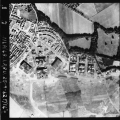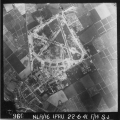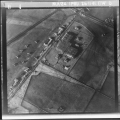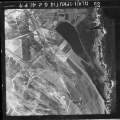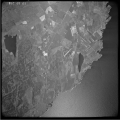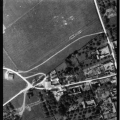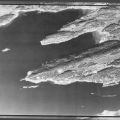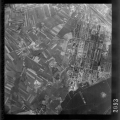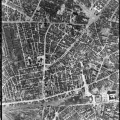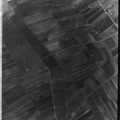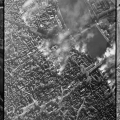Camouflage, Concealment and Deception
Hiding war assets from an enemy is central to military operations. Camouflage, concealment and deception techniques are used to hide, blend, disguise or disrupt the appearance of military targets.
- Camouflage involves disguising an asset and can be carried out by draping nets over equipment or painting disruptive patterns on an installation to make it blend into its surroundings.
- Concealment involves hiding an asset, such as covering equipment or installations with cut vegetation or draping with tarpaulin sheets to hide their existence or shape.
- Deception is designed to draw an enemy's eyes away from an asset, towards a dummy, or decoy, installation resembling the real target.
This feature introduces some examples of these methods; it is up to the reader to decide on their effectiveness.
Camouflaged airfields
Decoy airfields
Hidden V-1 launch site
|
Following devastating Allied air attacks on V-1 flying bomb launch sites in late 1943 and early 1944, the Germans began to construct a new type of launching site, which was much more difficult to recognise on aerial photography. Known as 'modified sites', these consisted of a metal ramp which could be constructed off-site and bolted onto concrete foundations, all of which could be deliberately concealed in a wood. Only three or four camouflaged huts were present at each of these new sites, making the whole operation much harder for Allied photo interpreters to find.
The site featured here is one such 'modified site'; the launch ramp is concealed among trees at lower left and the associated huts are disguised as farm buildings.
|
Hidden warship
| The German light cruiser Köln is visible at lower right in this image, moored parallel to the shore of Fettenfjord, Norway. The bow and stern of the ship have been blended into the shoreline by netting and floating material. The presence of an adjacent protective boom net, folded back on itself and resembling the outline of a ship, would have drawn the eyes of a photo interpreter to the spot, however, and revealed the cruiser's hiding place. |
Oil refinery
| During the Second World War, this oil refinery at Police, north of Szczecin, Poland, produced aviation fuel from crude oil and petrol from coal. As such, it was an attractive target for Allied bomber forces seeking to deny these fuels to the German military. This image shows that some of the oil storage tanks at Police were covered with netting in an attempt to conceal them. Oil installations typically cover large areas and possess a regular layout pattern which makes them difficult to hide from enemy aircraft during daylight hours. |
Decoy oil refinery
|
This dummy installation, designed to represent the Police oil refinery, was built in fields approximately 6 miles north of Szczecin. To complete the deception, a dummy pipeline was also laid between the decoy and the shoreline.
This decoy was unlikely to be mistaken for the real thing in daylight hours but at night, with realistic fires nearby, it could have deceived bomber crews into attacking it instead of the actual refinery. The absence of bomb craters in the vicinity of this site indicates the lack of effectiveness of this decoy. |
Hidden lake
|
During the Second World War, large bodies of water were of help to Allied bomber crews trying to locate their targets at night. The city of Hamburg had just such a body of water immediately adjacent to the city centre; in an attempt to draw Allied bombers away from this area, a scheme was developed to make the Binnenalster basin appear to be 500 metres north-east of its actual position. This was done by covering the basin with wood, wire-mesh and canvas structures painted to look like a series of city blocks, while a dummy Lombard's Bridge was built to cross the Aussenalster basin 500m to the north-east of the real bridge. The intention was that bombers using Binnenalster as an aiming point would drop their bombs harmlessly into the watery decoy.
In practice, Allied night bombing was not accurate enough to have limited damage to one specific area and after several heavy raids on the city the decoy was no longer maintained. Associated with this scheme, the railway lines at lower right were also painted to make them blend into the city street pattern.
|
Moving a city
Hiding a city
|
One solution to the problem of deceiving an enemy bomber intent on attacking a large, well-known target was to try and hide the target altogether. At Cologne, it was recognised that the city could readily be identified by its position on the River Rhine. The remedy was to place a series of smoke dischargers throughout the city which would be ignited on the approach of enemy aircraft and which could generate a smoke screen to cover the city and thereby mask the position of key aiming points.
In this image, the presence of the lone reconnaissance aircraft has caused some of the smoke generators to be switched on, particularly along the left bank of the Rhine, although much too late to deny the camera its view of the cathedral, bridges and railway station.
|
Night decoy
| This image shows a Special Fire, or 'Starfish', night urban decoy site south of Glasgow. Sites such as this one used a variety of electrically-ignited fire-making devices to simulate burning buildings and oil tanks, in an attempt to divert enemy bombers away from the real target at night. Visible at left of centre are the hard-standings for basket and oil drum fires; the control bunker can be seen adjacent to a field boundary wall to the south. |



